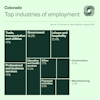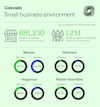 Stephanie Ferguson Melhorn
Stephanie Ferguson Melhorn
Senior Director, Workforce & International Labor Policy, U.S. Chamber of Commerce
Published
November 01, 2023
The state of Colorado has a favorable landscape for businesses and individuals, with a diverse economy, significant labor market recovery, and a robust small business ecosystem. Educational attainment, quality of life, and cost of living factors remain promising.
The Worker Shortage Across America
Explore the interactive map below to see the impact of the worker shortage crisis in each state.
Colorado’s Labor Market
Before the pandemic, Colorado's labor market was healthy. The state boasted a robust labor force participation rate of 68.8%, which was five points higher than the national average. Furthermore, its unemployment rate remained below the national average, at 3.2%. During that period, there were 79 available workers for every 100 open job positions.
As of August 2023, Colorado’s labor market has largely recovered, and continues to show signs of improvement. Both the unemployment rate and the labor force participation rate have returned to their pre-pandemic levels.
On the downside, the state is facing a worsened worker shortage, evidenced by the fact that there are only 52 workers for every 100 open jobs.
Colorado’s Business Environment
Colorado's business environment is diverse, encompassing prominent aerospace, technology, and infrastructure firms, industry-leading energy companies, abundant natural resources and parks, and various universities and research institutions.

Among industries monitored by the Bureau of Labor Statistics, the trade, transportation, and utilities sector, along with the professional and business services sector, employ the largest number of Coloradans, while manufacturing employs the fewest. Colorado’s employment landscape is a result of the state’s booming infrastructure and expanding technological investment, in addition to the state’s large oil, mining, and gas firms. Many jobs in Colorado work directly with the natural resources that are bountiful in the Centennial state, particularly in the areas of organic farming, outdoor recreation, and eco-tourism.

Colorado maintains a thriving small business ecosystem, encompassing 99.5% of all Colorado businesses. 47.6% of Colorado’s workforce is employed by small businesses, encompassing 1.2 million workers. Within this dynamic landscape, 44.7% of small businesses are women-owned, 7.7% are minority-owned, 11.6% are Hispanic-owned, and 7.2% are veteran-owned.
Colorado’s Educational Attainment

As of 2022, 93% of Colorado’s population has attained at least a high school diploma or its equivalent, which was higher than the U.S. average. Additionally, nearly 46% of the population earned a bachelor's degree, while 17.1% have completed a graduate degree, both well above U.S. national averages.

Fortunately for employers in the state, nearly 70% of Colorado college freshmen are remaining in-state for their higher education, where the average tuition is $9,144.
Out-of-state tuition in the Centennial state is $30,773, which is slightly more expensive than the national average of $28,000. In total, over 348,000 students were enrolled in a Colorado college for the 2022-2023 school year, supplying a rich pool for local employers to recruit top-notch talent.
Quality of Life

Colorado’s median income has been relatively volatile over the last decade. As of 2022, the state has a median household income of $89,930, ranking above the national average of $70,000 as 9th in the country. Colorado has a flat rate tax system of 4.4%, meaning that all taxpayers pay at this bracket regardless of income level.
Over 40 percent of Colorado’s workforce work remote at least one day a week, representing one of the highest proportions of teleworkers of any state in the United States. For those commuting into an office, the average commute time is 25.8 minutes. Colorado's cost of living index, as measured by the Council for Community and Economic Research (with the national average set at 100), stands at 105.5. This means that the state is slightly less affordable than national cost of living. The median rent settles at $1,335 while the median home cost is $555,300, both surpassing the national average. In 2021, and two-thirds of the population owned their housing unit, and the state experienced a .95% growth rate from 2020 to 2022.
Immigration

In the U.S., immigrants tend to be of working age in comparison to native-born individuals. As workers, these immigrants are also contributing to support programs like Medicare and Social Security.
Looking at Colorado in particular, immigrants comprise over nine percent of the state's population, totaling over 537,000 individuals. Their collective spending power amounts to $15.9 billion, while their tax contributions reach $5.5 billion.
Explore More States
About the authors

Makinizi Hoover
Makinizi Hoover is the Senior Manager of Strategic Advocacy at the U.S. Chamber of Commerce. She leads the housing portfolio and mobilizes resources to address high-priority issues, ensuring effective advocacy on key legislative and regulatory priorities.

Stephanie Ferguson Melhorn
Stephanie Ferguson Melhorn is the Senior Director of Workforce & International Labor Policy. Her work on the labor shortage has been cited in the Wall Street Journal, Washington Post, and Associated Press.

Isabella Lucy
Isabella has created stunning visualizations tackling pressing issues like the worker shortage, the benefits of hiring veterans, the lifespan of small businesses, and the future of work.





